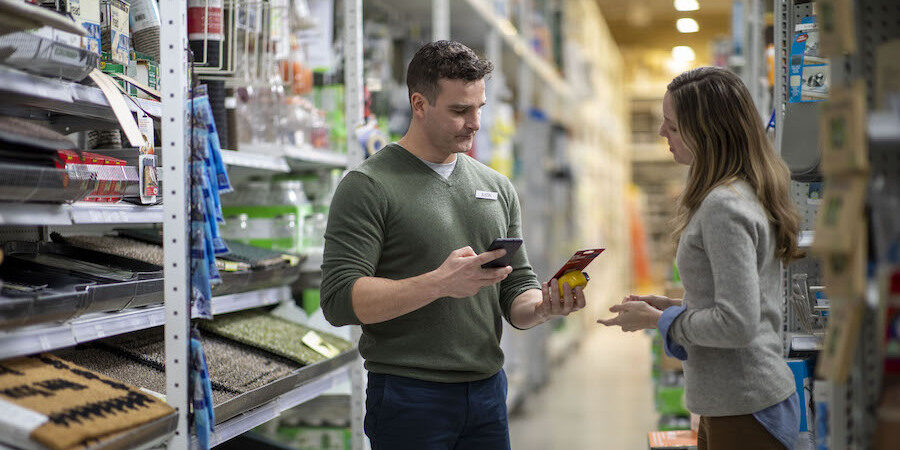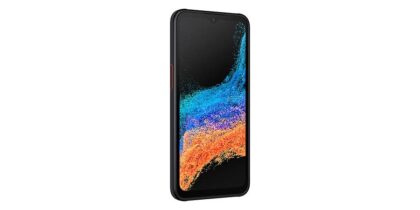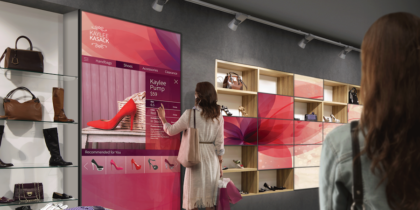For all the convenience of ecommerce, it’s worth remembering that brick-and-mortar stores offer a convenience of their own — the ability to get what you need right then and there, with help from a knowledgeable sales associate, and without the possibility of having to return an online order due to inaccurate product descriptions.
But if a customer arrives at your store and discovers they not only can’t find the item they need, but can’t even find a sales associate to talk to, or the associate can’t offer information at least as good as what the shopper already has, there’s a strong chance they’ll head right back out the door — maybe for good. That’s just one reason retailers’ top priority for the coming years should be making the retail experience smarter, more efficient and more predictable using associates equipped with mobility and in-store analytics.
The leaky dishwasher scenario
Consider this scenario: A man named Marco wakes up to find his dishwasher is leaking. He’s no plumber, but he wants to at least attempt a fix before paying for an expert.
So Marco troubleshoots with a quick Google search, lands on a couple of potential explanations for his dishwasher troubles, and, by using his local DIY big box store’s app to check inventory levels, is able to confirm that the store carries dishwasher repair items. He gets in his car and heads for the store.
Meanwhile, a sales associate named Jerry, who works at Marco’s closest branch, is alerted that Marco has been searching the store’s app for dishwasher repair and that he’s on his way over. When Marco arrives, Jerry greets him by name and asks what’s going wrong with his dishwasher.
Marco explains the situation, and Jerry runs through a series of questions on his tablet to help diagnose Marco’s problem. Jerry is able to recommend a fix, and confirms the store can offer the part at a lower price than competitors. He then shows Marco a two-minute video on how to complete the repair.
Based on Marco’s inexperience and the complexity of the fix, the two decide it’s better for Marco to get a plumber to make the repair. Jerry contacts a plumber, who schedules an appointment with Marco over the phone and takes over the service call from there.
Marco would never guess this was Jerry’s first day on the job. It didn’t matter. The store equipped Jerry with all of the tools and information he needed to help solve Marco’s problem.
How data helps retailers deliver great service
This level of service may not be entirely possible today, but retailers are already discovering the optimization benefits of equipping sales associates with phones and tablets. At times, they can even use mobile devices to untether cashiers from fixed POS stations, elevating them to the role of sales associates, to meet the customer where they’re making buying decisions: in the aisle.
Mobility helps retailers improve efficiency when it comes to stocking as well. Rather than scanning individual boxes, cameras can be used for barcode scanning and AI technology to scan and capture an entire row at once. Full-time order fulfillment personnel are now identifying stock outs and performing planogram compliance activities — all at the same time.
Using a one-device-to-one-employee ratio, retailers put the tools necessary to be productive directly in the hands of the people who need them. Think clocking in and out, peer-to-peer communications, task management and on-demand training. Add in new tools like Knox Asset Intelligence to help monitor the devices for location and battery life, for example, and managing thousands of employees across hundreds of locations becomes easier and more accurate.
This was the case for Walmart, after they rolled out 740,000 custom-configured Galaxy XCover Pro smartphones to associates, which now enables them to fulfill increasingly popular BOPAC (buy online, pickup at curb) and ecommerce orders. As a result, Walmart was also able to drive down the cost of associate technology systems including time and attendance and corporate communications.
Toward a mobile future
This massive shift in the way retail does business won’t happen overnight, but with the pandemic accelerating technology deployment, it’s time for retailers to start making strides toward delivering smarter, more personalized — and safer — experiences.
Transform retail associate performance
Get your free guide to empowering retail associates with mobile devices and data. Download Now
They’ll have to approach this from two angles:
- Building the hardware ecosystem: In the short term, retailers need to commit to in-store mobility. Equipping associates with mobile devices — such as Samsung’s Galaxy Tab Active3 or XCover Pro rugged devices — will enable stores to streamline workforce responsibilities, better serve customers and help employees be star sales associates from their first day on the job. In the longer run, it also means investing in IoT architecture, including cameras, sensors, IoT beacons and wearables to capture in-store data such as ecommerce transactions and an associate’s daily steps.
- Analyzing and leveraging the data: Of course, there’s no point capturing data unless you have the ability to use it to create breakthrough customer experiences. This is where partnering with data analytics companies will become a competitive advantage for retailers in the coming era of in-store analytics. Those analytics can offer organizations data sets they’ve never seen before, shaping how associates and customers alike are engaging in their work and shopping journeys, respectively. Are associates spending too much time on a single task, or too little? Are customers not increasing their basket size because items are hard to find? Businesses will be able to adjust store layouts and employee training mechanisms for better efficiency across the board.
Physical retail should learn from ecommerce, not fear it
Ecommerce stores capture and leverage data to provide exceptional, personal customer experiences. Brick-and mortar retailers can do the same thing using in-store mobility and IoT to provide convenience and a personal touch from corner to corner.
If you haven’t already, it’s time to start making serious steps toward a smarter, more mobile in-store sales experience. Give customers a reason to not only seek out your store, but browse, convert and keep coming back for more.
Evaluate your retail mobile initiative with this quick assessment to learn how it can better support great customer experiences. Looking for more cutting-edge retail solutions? Check out our full line of innovative retail technology.






